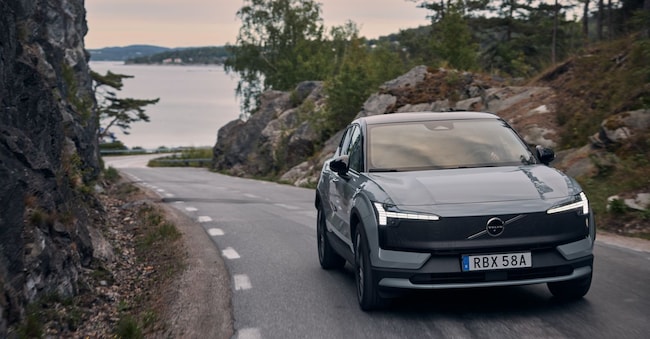Volvo EX30 Cross Country, testing the outdoor format of the compact electric SUV


The Cross Country model, absent from the Volvo range for years, is back. It was, to refresh your memory, retired despite having significantly boosted the brand's sales. Indeed, those versions outsold the standard models even where the increased ground clearance wasn't needed. So, essentially, it's a matter of style. Shelved along with all its aesthetic and technological features to avoid overlap with SUVs, the Cross Country format is back, but among the electric Volvos, generating the top-of-the-range version of the EX30. And, one might wonder, because its appeal could help boost the popularity of the compact electric SUV. It will be available in the coming months, but is already on sale for €54,000 with a nearly full-featured package, including all the most advanced safety and driver assistance systems.
This Volvo is derived from the most powerful EX30: the Twin Motor Performance Ultra, powered by a twin-motor powertrain with 428 horsepower and 543 Nm of torque, which also provides all-wheel drive. The system is powered by a 65 kWh battery integrated into a 400 V electrical grid, which can be charged with AC at up to 22 kW and DC at up to 175 kW, allowing for a 10 to 80 percent charge in less than half an hour and capable of providing a range of up to 427 kilometers. Ultimately, the Cross Country technically differs from the standard EX30 due to its integrated 19" wheels and 2.5 centimeters of raised ground clearance, which moves the height from 16.5 to 19 centimeters. This measurement brings the compact SUV's height from 1.55 to 1.57 meters, while, obviously, the length of 4.23 meters and the width of 1.84 meters remain unchanged, as does the 2.65-meter wheelbase that this Volvo owes to the modular SEA architecture developed by the Chinese group Geely.
Photo gallery 7 photos
In addition to its height, the Cross Country stands out aesthetically for its custom bodywork, crafted with familiar ingredients, similar to other road-going models that showcase its ability to venture into light off-roading. Distinctive features include the black plastic trim that protects the wheel arches and lower body sections. The package is completed by a custom grille, sealed, featuring a relief map of the Swedish Kebnekaise mountain range. It's black, like the other distinctive elements of this version, including the tailgate fascia that connects to the rear lights.
Unlike the exterior, the interior is virtually unchanged from the standard EX30. It's furnished in a very minimalist style, made with materials largely from recycled materials, but overall, it's subdued for the car's price, and it's highly digitalized. Too much so, in fact, because despite the ergonomics and, ultimately, the driver's concentration, very few physical controls are scattered haphazardly throughout the interior, as almost every function (even the heated rear window and glove compartment) is managed from the 12.3" vertical central infotainment display integrated with Google services, mounted on the dashboard. This, in turn, integrates the hi-fi soundbar. The passenger compartment offers a good amount of space in the front, but less so in the rear. The trunk has a capacity similar to that of smaller cars, ranging from 318 to 904 liters.
Capable of hitting a self-limited top speed of 180 km/h and 0-100 km/h in 3.7 seconds, this EX30 has a powertrain with a brilliant temperament just like that of the version from which it derives. It differs only slightly from the latter on a dynamic level because the raised suspension proves well-calibrated to combine agility and reliability through the curves with comfort, which is also benefited by the silence that reigns in the cabin.
I. The handling is overall pleasant but naturally not very engaging, as with the vast majority of electric cars.
News and insights on political, economic, and financial events.
Sign upilsole24ore





